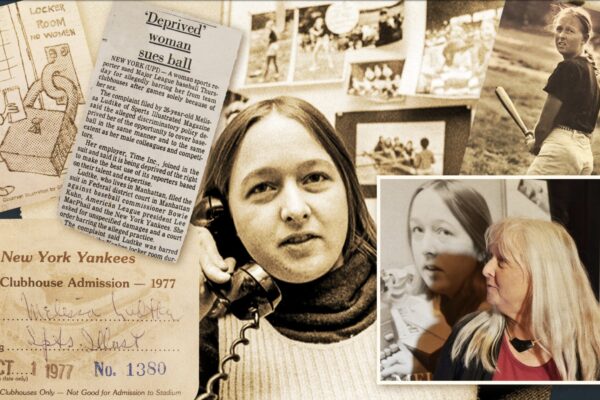By Devin Voss | @DevinVoss23
Sports Capital Journalism Program
INDIANAPOLIS — As the Baylor Bears tossed confetti into the air, cut down the nets, and hoisted their regional trophy following an 81-72 victory over the Arkansas Razorbacks in the South Regional championship game Monday night, a certain year continued to be mentioned.
1950.
That’s the last time Baylor made a Final Four. In those days, 6-foot-3-inch center Don Heathington and head coach Bill Henderson led a 14-13 Bears squad to an improbable victory over a 22-12 BYU team headlined by Mel Hutchins, a four-time NBA all-star and 2nd overall pick of the 1951 draft. A lot has changed in basketball since those Bears last advanced 71 years ago.
The NCAA Tournament now includes 68 teams. Back then the tournament held only eight, grouped into Eastern and Western regions. A four-region format with national semifinal games was two years away. That Baylor team averaged 53 points per game; these Bears average 83. Every player on the 1950 roster was 6-feet-3 or less. Today, the third-shortest player on Baylor’s 2021 roster, guard Jared Butler, is 6-foot-3.
Suddenly, two very different teams have something special to share.
“It means a tremendous lot to me but even more to the program,” senior MaCio Teague said. “No person is bigger than the program. What we did was history here. Really happy for Coach Drew. He’s been here for 18 years.”
After the success of the mid-20th century with its Final Four appearances in 1948 and 1950, Baylor basketball fell off the map. Between Henderson’s departure in 1961 and head coach Scott Drew’s arrival in 2003, Baylor had an overall record of 542-597. Four coaches — Gene Iba, Darrel Johnson, Harry Miller, and Dave Bliss — were hired and dismissed from 1985 to 2003. After their 1950 Southwestern Conference title, the Bears didn’t claim another conference championship win until earlier this month.
Given a chance to rebuild Baylor’s program following a successful one-year stint with Valparaiso, Drew has built one of the strongest programs in the nation. But it wasn’t always easy.
Through his first four seasons, it seemed as though Drew was yet another victim to the turmoil of what was Baylor’s basketball program. Drew’s Bears boasted a 36-69 record which included three seasons of single digit wins.
“I prayed about it, I felt led to come here,” Drew said about being hired in 2003. “Obviously once we got into the season and you found out that most of your team were walk-ons and most of them weren’t over 6-foot-2-inches, then you realized it might be tougher than you originally thought.”
However, he slowly turned the program around. In the 2007-08 season, he sent his first Baylor team to the NCAA Tournament. By 2021, he holds a 370-215 record, the Bears have captured their first Final Four, participated in their third Elite 8, have made nine NCAA tournaments, and won a NIT Championship.
“I really believed in the vision of the school, from the president and the administrators during that time and what they wanted Baylor to continue to grow and become,” Drew said. “Obviously the goal was always to build a program that could consistently compete and have an opportunity to play in March.”
Just a season ago, the Bears, with a 26-4 record — a career best coaching effort for Drew — were likely to be a No.1 seed before the tournament was canceled. This season Baylor appeared to be even better, stomping its way through the regular season and winning the Big 12, a program first, despite the program being put on a hiatus mid-season due to COVID-19. Heading into the matchup against No. 3 Arkansas, the Bears struggled to dispel fifth-seeded Villanova in the Sweet 16 but made a late game surge to seal their third Elite 8 appearance.
“That’s what makes this group special, is all of them work extremely hard on their craft,” Drew said. “They’re gym rats…They just love to get better in basketball. Couple of them sleep with balls. They just always got a rock in their hand and want to get better.”
Determined to not have another scare, Baylor was relentless to open the game against the Razorbacks. The Bears jumped out to a 13-2 start, shooting 71% and knocking down both of their three-point opportunities. When Jonathan Tchamwa Tchatchoua rose up and slammed down a two-handed dunk to extend the lead to 15-3, the fate of the Razorbacks was looking grim. The Bears continued to knock down shots and find holes in Arkansas’ zone defense. By the 11:01 mark, Baylor obtained its largest lead, 18 points, to go up 29-11. However, in the following three minutes, the Bears took a major blow when leading ball handler Davion Mitchell picked up his third foul of the evening.
With Mitchell out of the game, momentum started to swing in Arkansas’ favor. At 3:14, Arkansas, which had made eight of its last nine, overtook Baylor in shooting percentage with 62% to the Bears’ 60%. The Razorbacks closed the half on a 11-4 run to cut its deficit to 46-38.
Then, just 6:22 into the second half, Arkansas’ then-leading scorer, JD Notae, picked up his fifth foul and was forced to exit the game. While the Razorbacks remained nearby, getting as close as four points from a tie with 7:34 remaining, the Bears managed to pull away after Mitchell found Teague for back-to-back 3-pointers, upping their lead to 72-61 with 3:59 remaining. Adam Flagler’s 3-pointer with 55 seconds left maintained an 11-point lead.
In the glory of the moment, success was attributed to Drew.
“He just tries to build the trust in the relationship and it’s just not for basketball, he really cares,” Teague said. “He truly cares about the people and the program, truly cares about people and trying to put people in the best situation as possible.”


